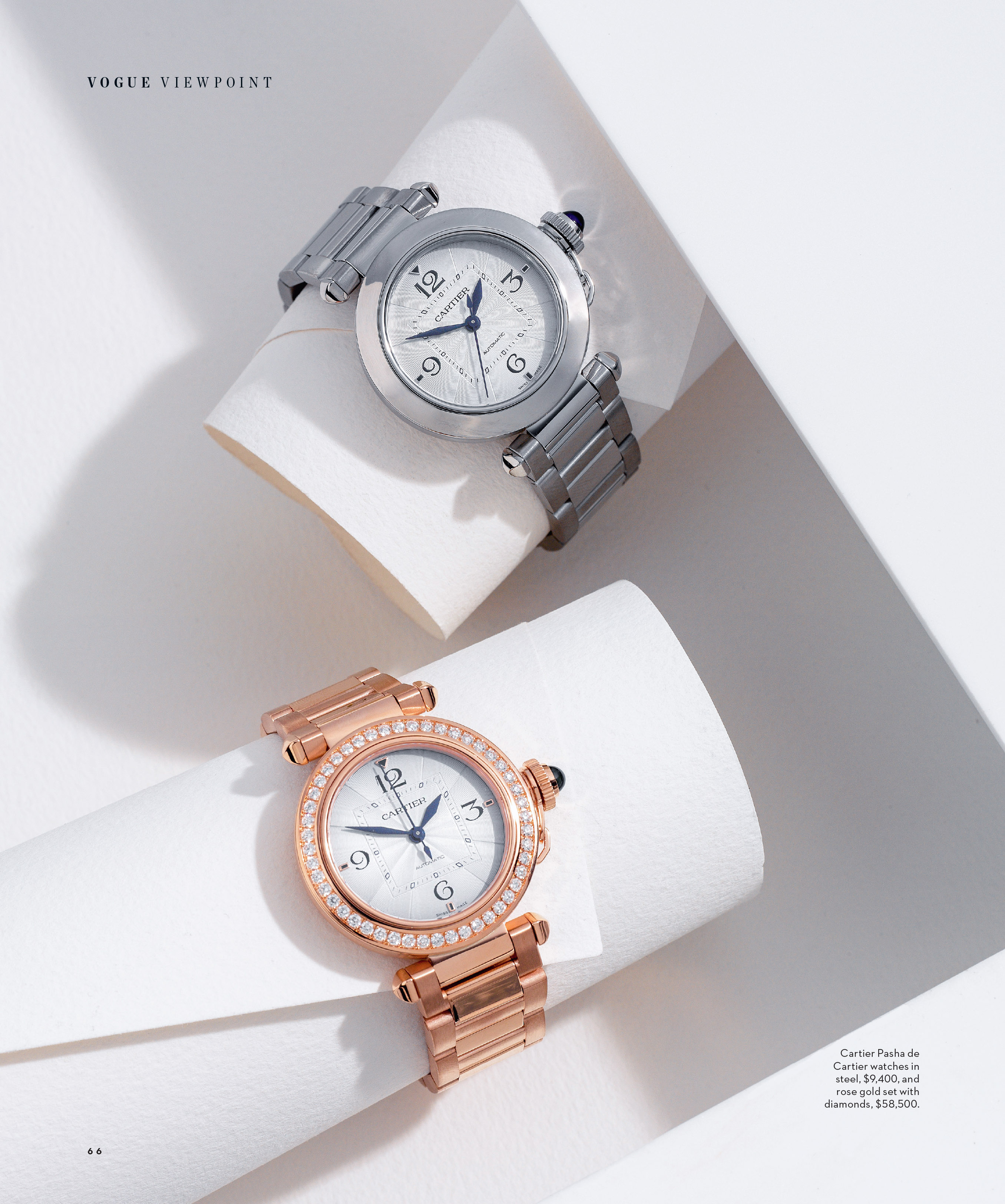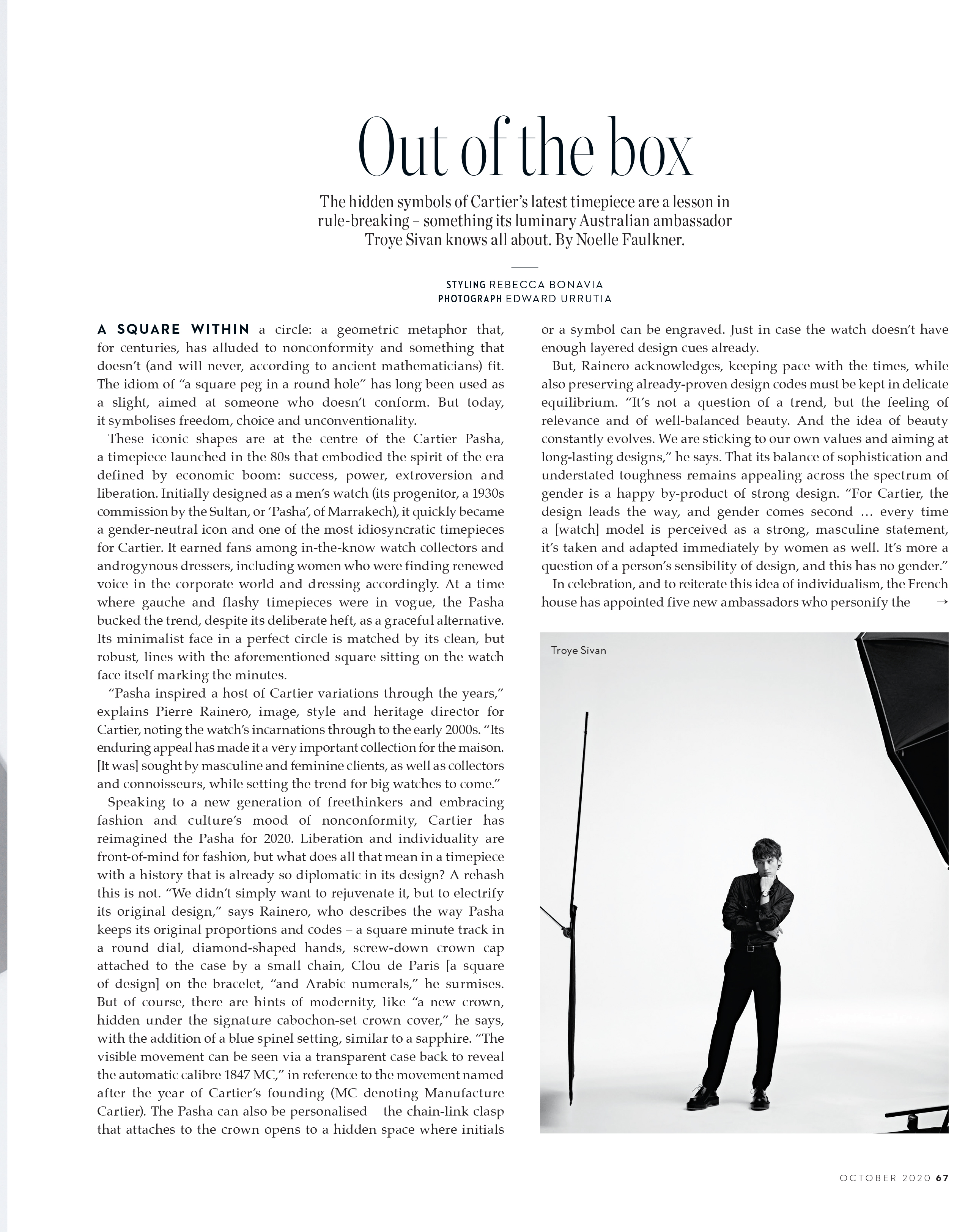
Vogue Australia, November 2020 (PDF)
The hidden symbols of Cartier’s latest timepiece are a lesson in rule-breaking – something its luminary Australian ambassador Troye Sivan knows all about. By Noelle Faulkner.
A square within a circle: a geometric metaphor that, for centuries, has alluded to nonconformity and something that doesn’t (and will never, according to ancient mathematicians) fit. The idiom of “a square peg in a round hole” has long been used as a slight, aimed at someone who doesn’t conform. But today, it symbolises freedom, choice and unconventionality.
These iconic shapes are at the centre of the Cartier Pasha, a timepiece launched in the 80s that embodied the spirit of the era defined by economic boom: success, power, extroversion and liberation. Initially designed as a men’s watch (its progenitor, a 1930s commission by the Sultan, or ‘Pasha’, of Marrakech), it quickly became a gender-neutral icon and one of the most idiosyncratic timepieces for Cartier. It earned fans among in-the-know watch collectors and androgynous dressers, including women who were finding renewed voice in the corporate world and dressing accordingly. At a time where gauche and flashy timepieces were in vogue, the Pasha bucked the trend, despite its deliberate heft, as a graceful alternative. Its minimalist face in a perfect circle is matched by its clean, but robust, lines with the aforementioned square sitting on the watch face itself marking the minutes.
“Pasha inspired a host of Cartier variations through the years,” explains Pierre Rainero, image, style and heritage director for Cartier, noting the watch’s incarnations through to the early 2000s. “Its enduring appeal has made it a very important collection for the maison. [It was] sought by masculine and feminine clients, as well as collectors and connoisseurs, while setting the trend for big watches to come.”
Speaking to a new generation of freethinkers and embracing fashion and culture’s mood of nonconformity, Cartier has reimagined the Pasha for 2020. Liberation and individuality are front-of-mind for fashion, but what does all that mean in a timepiece with a history that is already so diplomatic in its design? A rehash this is not. “We didn’t simply want to rejuvenate it, but to electrify its original design,” says Rainero, who describes the way Pasha keeps its original proportions and codes – a square minute track in a round dial, diamond-shaped hands, screw-down crown cap attached to the case by a small chain, Clou de Paris [a square of design] on the bracelet, “and Arabic numerals,” he surmises. But of course, there are hints of modernity, like “a new crown, hidden under the signature cabochon-set crown cover,” he says, with the addition of a blue spinel setting, similar to a sapphire. “The visible movement can be seen via a transparent case back to reveal the automatic calibre 1847 MC,” in reference to the movement named after the year of Cartier’s founding (MC denoting Manufacture Cartier). The Pasha can also be personalised – the chain-link clasp that attaches to the crown opens to a hidden space where initials or a symbol can be engraved. Just in case the watch doesn’t have enough layered design cues already.
But, Rainero acknowledges, keeping pace with the times, while also preserving already-proven design codes must be kept in delicate equilibrium. “It’s not a question of a trend, but the feeling of relevance and of well-balanced beauty. And the idea of beauty constantly evolves. We are sticking to our own values and aiming at long-lasting designs,” he says. That its balance of sophistication and understated toughness remains appealing across the spectrum of gender is a happy by-product of strong design. “For Cartier, the design leads the way, and gender comes second ... every time a [watch] model is perceived as a strong, masculine statement, it’s taken and adapted immediately by women as well. It’s more a question of a person’s sensibility of design, and this has no gender.”
In celebration, and to reiterate this idea of individualism, the French house has appointed five new ambassadors who personify the modern spirit of the Pasha: Rami Malek, Willow Smith, Jackson Wang, Maisie Williams and Australian musician Troye Sivan. “It sounds cheesy,” says Sivan, speaking to Vogue. “But you know that saying, ‘What makes you different are the things that make you beautiful’? I was fortunate to be explicitly praised and given love for the things that made me feel weird as a kid.” These, says the Johannesburg-born, Perth-bred musician and actor, include loving music, making YouTube videos and his sexuality. “They did not score me any cool points at school but ended up becoming what has defined and given me the most beautiful moments in my life.” This sense of independence early in his career – well before becoming a pop icon – taught Sivan the value of identity. “It freed me of the desire to try and find myself and my goals in the aspirations of other people. I try and fall back on what’s worked for me in the past: do what feels right, do what feels honest, tell the truth and make stuff that you’re proud of. And hopefully, it’ll connect with someone along the way. So far, it seems to be working.”
The 25-year-old has been a long-time friend of Cartier, a partnership that complements his love of fashion, design and detail. “Design is a huge part of my life, be it fashion or furniture, interiors, graphic design or typography,” he says. Sivan’s style often leans on accessories and as he’s gotten older, detail has become a priority. “Accessorising has the power to not only elevate an outfit but elevate the way that you feel. I think wearing a really great outfit of basics, like your favourite pair of jeans and a vintage tee or something like that, paired with the right accessories, can make you feel like a different person. I’m a firm believer in that and always have been.”
The weight of the watch and the ticks of the automatic movement that pulses at 28,800 vibrations per hour are also part-and-parcel of what makes Sivan “feel like a boss” when he wears it, he says, a throwback to the mood of the 80s when the watch made itself at home in the boardroom and at long lunches before the internet age. “I appreciate a little bit of a disconnect now and then. And I think there is something so beautiful about something tangible and mechanical. Not to rag on smart watches or anything like that, I’m sure they’re great. I just don’t want something to tap me on the wrist all day with news updates and messages and all this stuff.” He pauses: “Sometimes we need a reminder to take a second. We don’t need to be connected at all times. You don’t need to have access to the world or give the world access to you through your wrists. So to be able to take those moments where you give yourself a little break, wear something analogue and take a second to breathe, I think that’s really nice.”
Having just released his latest EP, In A Dream, Sivan has been further exploring his affinity for the 80s in not only his style, but also his music and accompanying imagery. “I grew up with my dad having concert DVDs of Toto, Sting and The Police, Michael Jackson and Madonna,” he says. “It was such a melodic time in music. A special melody can really punch me in the guts and make me pay attention to the music I’m listening to.” He adds: “Watching the music videos and growing up with that 80s aesthetic, it has a warm place in my heart, and it feels ... well, there’s a campness to it and a drama that I appreciate.” What inspires him the most about the 80s is a combination of high-low sounds and style. “I love how classic but flamboyant it feels.”
By Sivan’s statement, it is easy to see how this piece finds an admirer in him (and its four other ambassadors) and why the Pasha might once again be a symbol of youthful power, freedom and nonconformity. “Style, strength of character, energy,” says Rainero. “Pasha has always appealed to those who think big, regardless of gender, age or boundaries.” Like a piece of art or writing that has been passed through generations, this new incarnation of the watch might compel today’s wearer to make this highly symbolic timepiece their own. And in doing so, the meaning of the square inside a circle could change once again, hopefully from a symbol of difference to one of defiance.

